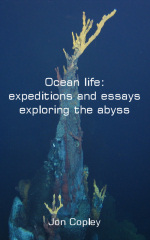Expedition links
NOC blog
The National Oceanography Centre, Southampton, is hosting a blog from the expedition at IntoTheCaymanAbyss.blogspot.co.uk, which should give a wider account of the voyage, with contributions from multiple team members about their work.
Adrian Glover's photo/video blog
Adrian is posting photos and short video clips to create a pictoral montage from the expedition on Google+
Southern Fried Science
Marine science blogger Andrew Thaler (aka Southern Fried Scientist) is aboard and may be posting updates from the expedition.
Twitter
Nearly half of our science team are on Twitter; please see the Team page for links to their IDs.
If you use Twitter and would like to ask our team members a question, please use the hashtag #DeepestVents
Background links
YouTube channel with footage of Cayman Trough vents from our 2010 expedition
Guardian article
Picture gallery and text about our previous discoveries at the deep-sea vents of the Cayman Trough.
National Geographic article
Report on our previous expedition in April 2010, which revealed the world's deepest known undersea volcanic vents.
Free eBook (in formats including for Kindle & iBooks)
Compilation of personal logs from previous expeditions, and articles about deep-sea vents, by Jon Copley.

Research papers
Nature Communications
Research paper presenting details of the geology, geochemistry and biology of deep-sea vents of the Cayman Trough, from data and samples collected during our previous expedition in March-April 2010. The paper is "open access", so no journal subscription is required to read it.
Rimicaris hybisae
Research paper describing a new species of vent shrimp, found at both of the vent fields seen so far in the Cayman Trough. Publication is (c) Cambridge University Press.
Lebbeus virentova
Research paper describing another new species of shrimp, from the Von Damm Vent Field. Publication is (c) Cambridge University Press.
Iheyaspira bathycodon
Research paper describing a new species of snail, found at the Von Damm Vent Field. Publication is (c) Cambridge University Press.
For schools
Find out more about the science behind our expedition, and how school classes of all ages can get involved.
What are we investigating?
